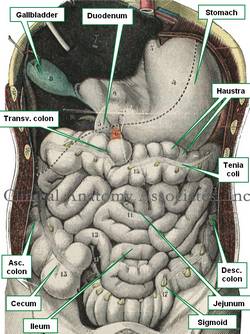|
The ileum is an intraperitoneal organ, it is the third portion of the small intestine and part of the digestive tract, found distal to the duodenum and jejunum. The ileum is about 6-8 feet in lenght.
There is no clear anatomical boundary between the jejunum and ileum, as they blend smoothly one into the other. There are several gross changes from jejunum to ileum, one of them being that the complexity of the mesenteric arterial arches increases from proximal to distal.
The term [ileum] has a Greek origin from [ειλεός] meanings "twisted", referring to the "twisted" look of this third portion of the small intestine. When the term was first used Galen did not separate or differentiate jejunum from ileum. He called both the [intestinum tenuis] or "thin or delicate intestine". This term is still used for the smaller arterial and venous branches of the small intestine, the [vasa intestinii tenuis].
It seems that the term "ileum" or "ileus" was originally used to denote the distal portion of the intestine that got sick or "colicky", separating it from the jejunum wich was usually found empty or devoid of food.
The terminal ileum ends at the ileocolic or ileocecal valve, where the small intestine empties its contents into the large intestine or colon.
|



